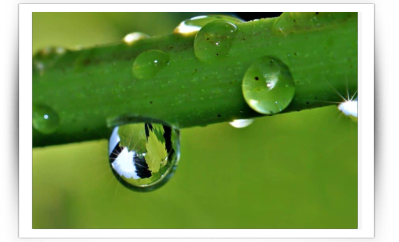Humans can get by in the most basic of shelters; can scratch together a meal from the most humble of ingredients. But we can't survive without clean water. And in places where water is scarce -- the world's deserts, for example -- getting water to people requires feats of engineering and irrigation that can be cumbersome and expensive. A pair of new studies from researchers at The Ohio State University offers a possible solution, inspired by nature. "We thought: 'How can we gather water from the ambient air around us?'" said Bharat Bhushan, Ohio Eminent Scholar and Howard D. Winbigler Professor of mechanical engineering at Ohio State. "And so, we looked to the things in nature that already do that: the cactus, the beetle, desert grasses." The cactus, beetle and desert grasses all collect water condensed from nighttime fog, gathering droplets from the air and filtering them to roots or reservoirs, providing enough hydration to survive. Drops of water collect on wax-free, water-repellant bumps on a beetle's back, and then slide toward the beetle's mouth on the flat surface between the bumps. Desert grasses collect water at their tips, and then channel the water toward their root systems via channels in each blade. A cactus collects water on its barbed tips before guiding droplets down conical spines to the base of the plant. Bhushan's team studied each of these living things and realized they could build a similar -- albeit larger -- system to allow humans to pull water from nighttime fog or condensation. They started studying the ways by which different surfaces might collect water, and which surfaces might be the most efficient. Using 3D printers, they built surfaces with bumps and barbs, and then created enclosed, foggy environments using a commercial humidifier to see which system gathered the most water.
They learned that conical shapes gather more water than do cylindrical shapes --
|
"which made sense, given what we know about the cactus," Bhushan said. The reason that happens, he said, is because of a physics phenomenon called the Laplace pressure gradient. Water gathers at the tip of the cone, then flows down the cone's slope to the bottom, where a reservoir is waiting. Grooved surfaces moved water more quickly than ungrooved surfaces -- "which seems obvious in retrospect, because of what we know about grass," Bhushan said. In the research team's experiments, grooved surfaces gathered about twice as much water as ungrooved surfaces. The materials the cones were made out of mattered, too. Hydrophilic surfaces -- those that allowed water to bead up rather than absorbing it -- gathered the most water. The research team also experimented on a structure that included multiple cones, and learned that more water accumulated when water droplets could coalesce between cones that were one or two millimeters apart.
*source: https://www.sciencedaily.com/releases/2018/12/181226132827.htm
 *Image source: https://www.alwaysresearching.com/technology/engineering/20181231/collecting-clean-water-from-air-inspired-by-desert-life/
*Image source: https://www.alwaysresearching.com/technology/engineering/20181231/collecting-clean-water-from-air-inspired-by-desert-life/
|